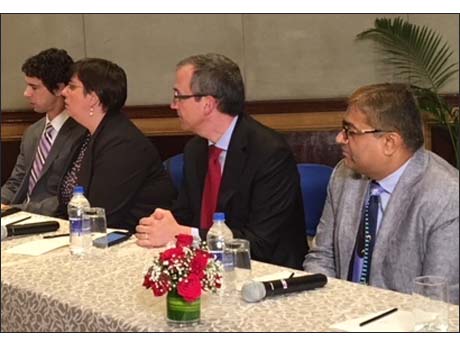
Bangalore, June 22, 2018: Behind the successful development of Indian missile systems like Brahmos, lies lakhs of lines of software coding, controlling dozens of critical sub systems. Before the missile is certified ready to fly, all this software needs to be rigorously checked -- and to do this, the developers subjected themselves to an external audit that goes into the entire software development process and assesses the maturity of the process. The auditors who did this were a team from Software Quality Center (SQC) led by their founder-CEO, Krishnan ('Kris') Puthucode.
Yesterday, Kris and his colleagues were busy in Bangalore, conducting training for engineers from many of India's strategic industries in defence, aerospace and atomic energy, on CMMI V2.0 model, the new version of the industry standard known as Capability Maturity Model Integration or CMMI. It was the first such workshop in Asia and only the seconf worldwide conducted by SQC.
Later in the day they were joined by executives from the CMMI Institute -- Kirk Botula, CEO, Katie Tarara, Director and Mathew Maroon, Director, Product Line, to formally introduce the tech community to the new standard.
"This is the Gold Standard in Quality benchmark ratings for Software and service organizations", said Kris, speaking to IndiaTechOnline yesterday, " From the late 1990s, we have been here to help Indian companies to improve, using the best practices prov, home to a cluster of high tech industries in the semiconductor and electronics space, SQC has carved a niche for itself as a prefered partner for quality assurance and benchmarking for strategic industries.
Adds Kris: “Some of the best talent in India resides in Aerospace, Defense, Medical devices and high-tech- and this is the Industry we have solely focused on since our inception in India as well as globally headquartered in the US.”
CMMI V2.0 is a major update with a completely re-branded, re designed new model that is more modern, agile and seeks to replace the earlier v1.3 with state of the art best practices that aims at ease of use, adoption and high reliability of these quality ratings.
In recent weeks, SQC completed 15 years as a partner with the CMMI Institute., certified to deliver CMMI related training and appraisals worldwide. “This is a proud moment for us. As it recognizes the hard work and effort to succeed in a market like India. SQC also works with the US Department of Defense and many Aerospace companies to help them elevate performance and build capability by using best practices that are proven and tested”, says Kris. Read our report here.
Kris started as one of the top Lead Assessors in the CMMI Space in India 17 years ago. Prior to starting SQC, he performed in varied capacities in software engineering, software management, Quality models and standards, marketing and business development in companies including Raytheon BBN Technologies, Coopers and Lybrand (now PWC), and Centre for Development of Advanced Computing (C-DAC). under the Ministry of Electronics, Government of India.
Kris holds Computer Science Engineering degree, and Management and Executive education from the Stanford Graduate School of Business.
--------------------------------------------------------------------------------------------------------------------------------------------------
TechNote: What is CMM?
The Capability Maturity Model (CMM) is a development model created after a study of data collected from organizations that contracted with the US Department of Defence, who funded the research. The term "maturity" relates to the degree of formality and optimization of processes, from ad hoc practices, to formally defined steps, to managed result metrics, to active optimization of the processes.
The model's aim is to improve existing software development processes, but it can also be applied to other processes. It has been, and continues to be widely applied as a general model of the maturity of process. ( from Wikipedia)